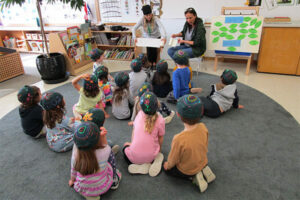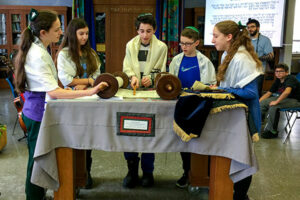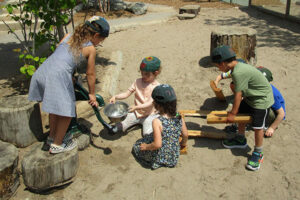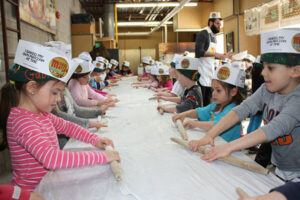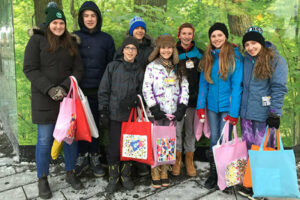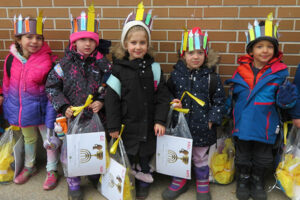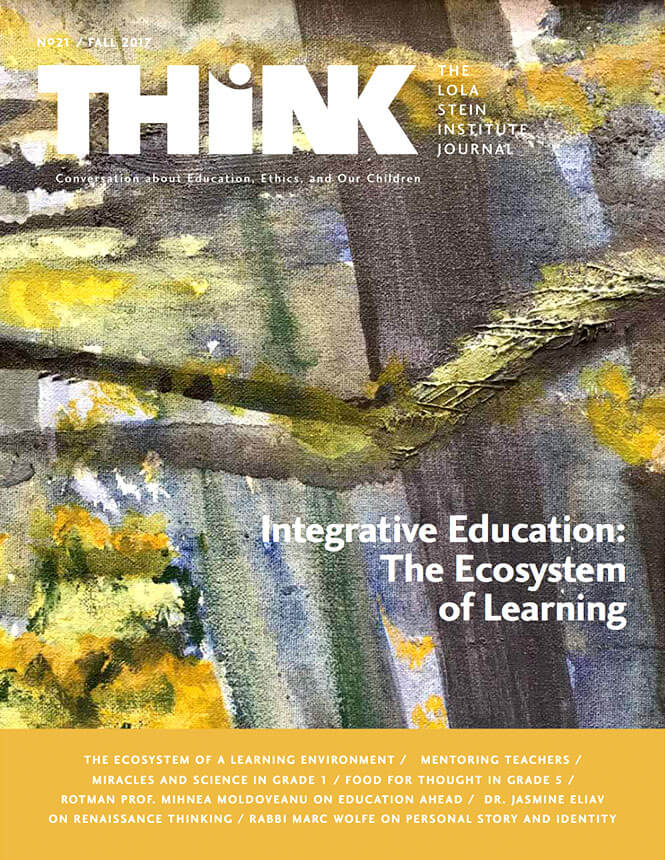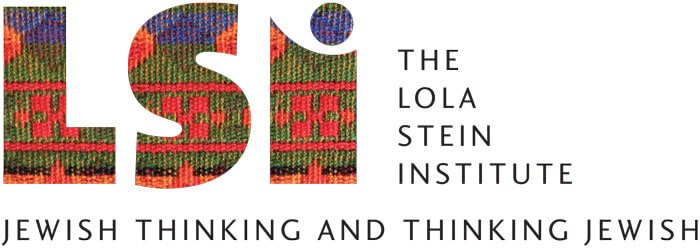- How We Teach

- First Column
- Second Column
- Third Column
- Case Studies

- First Column
- Second Column
- Culture & Community

- First Column
- Second Column
- News & Views

- Admissions

- First Column
- Second Column
- Support Us

- About

- First Column
- Second Column
- Parent Hub
- Attend an Open House
- Take a Tour
- Donate Now
- Calendar
- Blog
- 416-635-1876
- Search
Beyond the Buzz
Integrated Learning at The Toronto Heschel School
The words, “integrated” and “integration,” bounce around schools these days. Let’s be clear; their usage is very unclear. Schools do not use these terms in the same way. Their meaning originates in “bringing together parts of a whole” from early French, and “renewal” from late Latin.
Picture baking a cake: you select and measure flour, salt, baking powder, sugar, eggs, oil, and so on. You bring together and mix the ingredients in a bowl, pour the mixture into a cake pan, place it in the oven, and bake; what comes out is a whole new delicious creation. There are many recipes for cakes. The challenge is to select and handle ingredients that turn out a beautiful scrumptious product. At Toronto Heschel, carefully identified ingredients converge in thoughtfully planned units of study where four kinds of interaction transpire. Each of these is an essential ingredient without which integration – Toronto Heschel School style – cannot take place: they are teaching the whole child, learning through the arts, thinking in academic disciplines, and connecting academic disciplines through thematic study.
1. Body, Mind, Spirit
Integrative education nurtures the whole child all day, premised on the interaction and interdependence of mind, body, and spirit. An acceptance of learning for complexity is essential on all levels; each child is a composite of many attributes, sensibilities, and circumstances. More than academics happens for the child at school. The day embraces social and emotional development, mobilizing individual expression through music, literature, dance, and visual arts, while pinpointing and supporting attributes which aid or complicate each child’s progress. The Jewish Canadian child owns a double identity—Jewish and Canadian— and integrative education welcomes the combination, neither dividing the day in half to distance the characteristics one from another nor separating universal study from Jewish study to filter each artificially.
An example of teaching the whole child is the Grade 7 unit “Experience is a Sign for me to Shine!” In this unit, 12 year-olds reflect on peer influence and engagement. The pre-teens examine social pressure as a historical phenomenon while studying ancient civilizations and Jewish responses to Hellenism in Judea at the time of the Maccabees. They observe how circumstances provide opportunity to strengthen values and let identity shine. Making the dilemmas of ancient history personal, students craft and design a Chanukiah to symbolize how they manifest their own Jewish identity in a secular, pluralistic world. They are growing young adults, a perfect age to be introduced to the practice of contextualizing Jewish identity among different influences in their lives.
2. Expression
Learning is the expression of understanding. Integration through the arts uses music, literature, dance, and visual arts as catalysts to expression beyond the constraints of words and numbers. Judith Leitner, Director of Integrated Arts, writes,
We see how the process of creating vivid imagery, sound, language and movement engages a multiplicity of senses and makes visible a learner’s unique voice… the arts stretch our minds, enabling inventiveness and expressivity as open-ended illuminations of points of view or mindsets crafted as questions, uncertainties, deliberate contradictions, provocations or as a bold deconstructions of form, space or time….Most importantly, we recognize that arts have the capacity to cultivate our most essential life tool: the art of self-esteem.
In Grade 4, students read a novel in small groups, analyze components of plot and character, and collaboratively write an original play that sees them perform their understanding of the novel. Drama, music, and visual arts become their tools as they digest and convey the novel in new ways. “The Beautiful Triangle” is a Grade 7 multi-disciplinary study that integrates geometry, aesthetics, language, the history of ideas, and visual arts. Students learn how the ancient Greeks used geometry as an analytical device, such as Thales’s use of similar triangles to measure the heights of pyramids. They meet the visual art of Wassily Kandinsky and engage with geometry and the properties of triangles to express their thoughts and ideas.
3. Disciplined Thinking
Academic disciplines may be the building blocks for everything that children learn. Mastering a discipline involves proficiency in the way of thinking that is specific to that field of study; a mathematician may approach numbers differently than a geographer handles topography. When coursework is structured for students to think as the respective academic disciplinarian would think, they learn the subject matter with enhanced internalization. In each discipline there are three lines of inquiry. For example:
- What does science teach? How do scientists think? How do we inquire as scientists?
- What history does tell us? How do historians think? How do we research into the past as historians would do it?
- What does the Talmud say? How did rabbis of the Talmud think and argue? How do we engage with text in the Talmudic fashion?
An important integrative interaction happens through the disciplinary approach. While each field of study offers content and sharpens specific cognitive abilities (logical, evaluative, inductive), student engagement with such variety of distinctive ways of thinking strengthens flexibility in habits of mind, which is as valuable a life skill as an academic one. The metacognitive aspect is also significant; students become more aware of their own actions and thoughts: “This is how I’m thinking; this is what I’m doing.” Self-awareness and self-regulation of strategy and performance are critical in the development of independent thought and other life skills.
For example, the discipline of science involves inquiry arising from curiosity about the physical world. Scientists observe, hypothesize, experiment, and reach provisional conclusions that lead to more questions. The children begin learning to observe in Junior Kindergarten and, by Grade 1, they are primed for the Scientific Method. They observe nature and learn about metamorphosis; they watch matter – for example, water – change between solid, liquid, and gas. Consciously using the thought process and language of scientists, they ask, “How does matter change between solid, liquid, and gas?” Step by step, they develop a hypothesis, experiment, observe results, and draw conclusions. The scientific approach becomes theirs.
Grade 4 students learn the equally specialized skills of social scientists, exploring Canadian culture, natural resources, and geography through authentic artifacts and folk habits. Examining domestic utensils, old maps, songs, visual art, photography, and stories, students uncover the spirit of each Canadian province through the expressions of the people who live there.
4. Complex Thinking
Interdisciplinary approach is another ingredient. It sees synchronized topics weave skills and ethics together. The result is a more advanced learning of both. Coursework in different academic disciplines is coordinated by a single framework that centres around an overarching “big idea” with an ethical premise. Students keep the big idea in mind while learning skills that fulfill (or exceed) the academic demands of their grade.
The big idea in one Grade 3 integrated unit is to bring students to appreciate the important relationship between self-awareness and self-regulation, on the one hand, and social responsibility and action, on the other. The unit is called “Be responsible for myself, think of others, and act now!” Coursework weaves in the Jewish ethic, “If I am not for myself, who will be for me. If I am only for myself, what am I?” (Ethics of the Fathers/ Pirkei Avot 1:14).
In language arts, the children take on the role of poets and share personal reflections about themselves. In math, they study place values and see how numbers depend on each other for their value. Perhaps as with people, unique face value is important, but interaction with others has consequences: digits such as “3” or “4” have an individual “face” value, but change total value according to their “place” within a larger number, 234 or 43. Studying ecosystems, in science class, the children observe a single organism’s unique role, yet each organism impacts all others. First raising, then releasing salmon, they watch the living things meet own needs while supporting the well-being of all. In Chumash class, students consider how, like Abraham in the Torah, every name can be a blessing כל שם יכול להיות ברכה. They learn that a “good name” is acquired on assuming responsibility for ourselves and others through deeds (mitzvot) and the Ethical Path (Derekh Eretz).
Returning to the cake: what is produced by the four process above does not resemble any one part of the ingredients. The cake is the personal awareness that each child feels when making sense of the learning. Recently, in a joint presentation, two Toronto Heschel graduates said,
In every class… there are hundreds of dots that are being connected. All of our classes share a common thread, a generative topic that can link to Talmudic studies, art classes, music, poetry, dance and so much more. Not only do you learn to dance, to sing, and to write but also, you learn how to integrate diverse ideas and concepts.
Another much older graduate described integrative thinking at Toronto Heschel as “an operating system that just runs inside.” Well accustomed to integrative thinking, graduates continue to amaze and inspire us as learners, thinkers, Jews, and human beings.
Dvora Goodman Pam Medjuck Stein , CoordinatorChair of The Lola Stein Institute and Editor of Think MagazineDvora Goodman is a Jewish educator with over twenty five years of experience in educational administration and Jewish experiential learning in various settings. She is the coordinator of The Lola Stein Institute. She is also an educational consultant to various Jewish educational organizations. Her current projects include UJA Federation of Greater Toronto where she has been coaching supplementary school leaders in the Greater Toronto area, and the iCenter for Israel Education where she has been helping Jewish camps and Jewish day schools infuse Israel into their settings.
Pam co-founded the Lola Stein Institute in 2003. She was a founding parent of The Toronto Heschel School in 1996 and served on its Board of Directors as Treasurer, Co-Chair, and Director. She is active across the community and currently sits on the Board of Directors of the Canadian Jewish News, the Canadian Friends of the Shalom Hartman Institute and the North American Alumni Delegate Council of the Wexner Heritage Foundation. She and her husband, Michael Stein, recently established The Diabetes Leadership Foundation to strengthen organizations that mentor better diabetes self-management.
Pam earned a Master of Laws from the London School of Economics, pursued further training in cultural property in London and Paris and practiced law in Toronto. Pam introduced collective copyright management to Canadian visual artists in 1984 by establishing VIS ART Copyright Inc. linking Canadian artists to international copyright management through UNESCO. She has been Co-Chair of the LEAF Foundation (Women’s Legal Education and Action Fund) and a Fellow of the Aspen Institute for Humanistic Studies.
PREVIOUS ARTICLE
Good Books by Gail BakerNEXT ARTICLE
The World Is My TeacherSpecial Feature
Satisfaction GuaranteedFood for ThoughtMatter, Metamorphosis, and Miracles in Grade 1The World Is My TeacherIntegrated Learning at The Toronto Heschel SchoolBeyond the BuzzOur Sages Tell Us
The 21st Century Renaissance ThinkerChaos and OrderNarrative and IdentityWho Tells Your Story? Who Tells Ours?Re-Designing Formative Education on the Eve of the Fourth Industrial RevolutionTranscendental LearningColumns
Recommendations for Children and the People Who Love ThemGood Books by Gail BakerAn Ecosystem for Successful LearningSchool of SalmonPerspectives
 The Lola Stein Institute (LSI) is a centre of inventive educational thinking and addresses the challenge to re-frame schooling for the exigencies of our times.
The Lola Stein Institute (LSI) is a centre of inventive educational thinking and addresses the challenge to re-frame schooling for the exigencies of our times.

